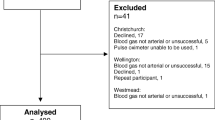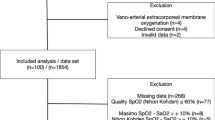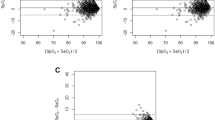Summary
Objective
Continuous measurement of the functional oxygen saturation with a pulse oximeter (SpO2) is used to monitor sufficient oxygenation. The measurement can lead to falsely high or falsely low values compared to the gold standard (arterial blood gas analysis, SaO2). The aim of this study was to identify pulse oximetry safety levels to prevent unrecognised hypoxic episodes.
Methods
A retrospective analysis of 250 patient records was performed and 1,000 data pairs (simultaneous measurement SaO2 and SpO2) were collected. Bland-Altman analysis was used to evaluate the systematic (bias) and random error (precision) in measurement. The safety levels were determined 1) by graphical analysis of the correlation between SaO2 and SpO2 and 2) by tabular cluster analysis.
Results
Bland-Altman analysis revealed a good correlation between SaO2 and SpO2. The mean bias between the two techniques was calculated as ΔS=+0.5±2.32%. For a 95% confidence level (error probability 5%) pulse oximetry safety levels of 98% (89 and 86%) were identified to reach a SaO2 of 95% (90% and 85%).
Conclusion
To maintain a SaO2 of 95% (90 and 85%) pulse oximetry readings of 98% (89 and 86%) or more are required, if an error probability of 5% is accepted. Compliance with these safety levels during intensive care routine treatment may help to reduce the incidence of unrecognised hypoxic episodes (e. g. SaO2 below 95%).
Zusammenfassung
Einleitung
Die kontinuierliche Messung der funktionellen Sauerstoffsättigung mit einem Pulsoxymeter (SpO2) dient der ununterbrochenen Überwachung einer ausreichenden Oxygenierung. Dabei kann die Messung im Vergleich zum Goldstandard (arterielle Blutgasanalyse, SaO2) zu falsch hohen oder falsch niedrigen Messwerten führen. Das Ziel dieser Untersuchung war die Identifizierung von pulsoxymetrischen Sicherheitsniveaus, um unbemerkte hypoxische Episoden zu vermeiden.
Material und Methoden
In einer retrospektiven Krankenaktenanalyse wurden bei n=250 intensivmedizinischen Patienten insgesamt n=1000 Messwertpaare (zeitgleich SpO2 und SaO2) analysiert. Mit der Methode nach Bland-Altmann wurden der systematische (Bias) und zufällige Messfehler (Variabilität) evaluiert. Die Sicherheitsniveaus wurden 1) grafisch durch die Analyse des Zusammenhangs zwischen SaO2 und SpO2 und 2) tabellarisch durch eine Gruppenanalyse ermittelt.
Ergebnisse
Durch die Analyse nach Bland-Altmann wurde eine gute Korrelation zwischen SaO2 und SpO2 gefunden. Der mittlere Bias betrug ΔS=+0,5±2,32%. Als pulsoxymetrische Sicherheitsniveaus wurden auf der Basis einer statistischen Sicherheit von 95% (Fehlerwahrscheinlichkeit 5%) minimale SpO2-Werte von 98% (89 bzw. 86%) identifiziert, falls eine SaO2 von 95% (90 bzw. 85%) eingehalten werden sollte.
Schlussfolgerung
Zur Einhaltung einer SaO2 von 95% (90 bzw. 85%) ist bei einer akzeptierten Fehlerwahrscheinlichkeit von 5% ein pulsoxymetrischer Messwert von mindestens 98% (89 bzw. 86%) erforderlich. Die Einhaltung dieser Sicherheitsniveaus während der intensivmedizinischen Routinebehandlung kann helfen, die Inzidenz unbeabsichtigter hypoxischer Episoden (z. B. SaO2<95%) zu vermindern.
Similar content being viewed by others
References
Aoyagi T, Kishi M, Yamaguchi K, Watanabe S (1974) Improvement of the earpiece oximeter. Abstracts of the 13th annual meeting of the Japanese Society ofMedical Electronics and Biological Engineering, pp 90–91 (Jap)
Bland JM, Altman DG (1986) Statistical methods for assessing agreement between two methods of clinical measurement. Lancet I:307–309
Buschman A, Morris R, Warren D, Philip J, Raemer D (1987) Pulse Oximetry And The Incidence of Hypoxemia During Recovery From Anesthesia. Anesthesiology 67:3A
Comroe JH, Bothello S (1947) The unreliability of cyanosis in the recognition of arterial anoxemia. Am J Med Sci 214:1–9
Cote CJ, Goldstein EA, Fuchsman WH, Hoaglin DC (1988) The effect of nail polish on pulse oximetry. Anesth Analg 67(7):683–686
Eichhorn JH (1989) Prevention of intraoperative anesthesia accidents and related severe injury through safety monitoring. Anesthesiology 70:572–577
Gil NP, Wright B, Reilly C (1992) Relationship between hypoxaemic and cardiac ischaemic events in the perioperative period. Br J Anaesth 68:471–473
Hinkelbein J, Hose D, Ellinger K (2002) Pulsoxymetrie: Grundlagen, Funktionsprinzip, Anwendungsmöglichkeiten. Rettungsdienst 25:1067–1071
Hinkelbein J, Genzwuerker H, Fiedler F (2003) Reliability and Variability of Oxygen Saturation determined by Pulse Oximetry in Intensive Care Patients. Anesthesiology 99:452
Hinkelbein J, Osika A, Fiedler F (2004) Accuracy and precision of pulse oximetry in ventilated patients of an intensive care unit. Eur J Anaesthesiol 21(Suppl 32):179
Hinkelbein J, Koehler H, Fiedler F (2004) How artificial nails with applied nail polish do alter oxygen saturation determined by pulse oximetry. Eur J Anaesthesiol 21(Suppl 32):42–43
Hinkelbein J, Sogl R, Genzwürker HV, Fiedler F (2004) Nail polish: Bias Evaluation and Accuracy Validation for the Measurement of Oxygen Saturation determined by Pulse Oximetry. J Emerg Med 26(3):377
Hinkelbein J, Osika A, Genzwürker H, Fiedler F (2004) Identifizierung eines 95%-Sicherheitsniveaus zur Vermeidung falsch hoher pulsoxymetrischer Messwerte. Intensivmed 41 (Suppl 1):I/23–24
Hinkelbein J, Genzwürker HV, Fiedler F (2005) Detection of a Systolic Threshold for Reliable Readings in Pulse Oximetry. Resuscitation 64(3):313–317
Jensen LA, Onyskiw JE, Prasad NGN (1998) Meta-analysis of arterial oxygen saturation monitoring by pulse oximetry in adults. Heart Lung 27(6):387–408
Jubran A (2004) Pulse oximetry. Intensive Care Med 30:2017–2020
Moller JT, Johannessen NW, Espersen K (1993) Randomized evaluation of pulse oximetry in 20 802 patients: II. Perioperative events and postoperative complications. Anesthesiology 78:445–453
Pedersen T, Moller AM, Pedersen BD (2003) Pulse oximetry for perioperative monitoring: systematic review of randomized, controlled trials. Anesth Analg 96:426–431
Ralston AC, Webb RK, Runciman WB (1991) Potential errors in pulse oximetry. III: Effects of interferences, dyes, dyshaemoglobins and other pigments. Anaesthesia 46(4):291–295
Seguin P, Le Rouzo A, Tanguy M, Guillou YM, Feuillu A, Mallédant Y (2000) Evidence for the need of bedside accuracy of pulse oximetry in an intensive care unit. Crit Care Med 28(3):703–706
Severinghaus JW, Honda Y (1987) History of blood gas analysis. VII. Pulse oximetry. J Clin Monit 3(2):135–138
Severinghaus JW, Spellman MJ Jr (1990) Pulse oximeter failure thresholds in hypotension and vasoconstriction. Anesthesiology 73(3):532–537
Severinghaus JW, Kelleher JF (1992) Recent developments in pulse oximetry. Anesthesiology 76:1018–1038
Tinker JH, Dull DL, Caplan RA, Ward RJ, Cheney FW (1989) Role of Monitoring Devices in Prevention of Anesthetic Mishaps: A Closed Claims Analysis. Anesthesiology 71:541–546
Van de Louw A, Cracco C, Cerf C, Harf A, Duvaldestin P, Lemaire F, Brochard L (2001) Accuracy of pulse oximetry in the intensive care unit. Intensive Care Med 27:1606–1613
Wouters PF, Gehring H, Meyfroidt G, Ponz L, Gil-Rodriguez J, Hornberger C, Bonk R, Frankenberger H, Benekos K, Valais J, Avgerinos J, Konecny E (2002) Accuracy of pulse oximeters: the European multi-center trial. Anesth Analg 94(1 Suppl):S13–16
Author information
Authors and Affiliations
Corresponding author
Rights and permissions
About this article
Cite this article
Hinkelbein, J., Osika, A., Genzwürker, H.V. et al. Identifizierung von pulsoxymetrischen Sicherheitsniveaus zur Vermeidung unbemerkter hypoxischer Episoden. Intensivmed 42, 653–660 (2005). https://doi.org/10.1007/s00390-005-0628-3
Received:
Accepted:
Issue Date:
DOI: https://doi.org/10.1007/s00390-005-0628-3




